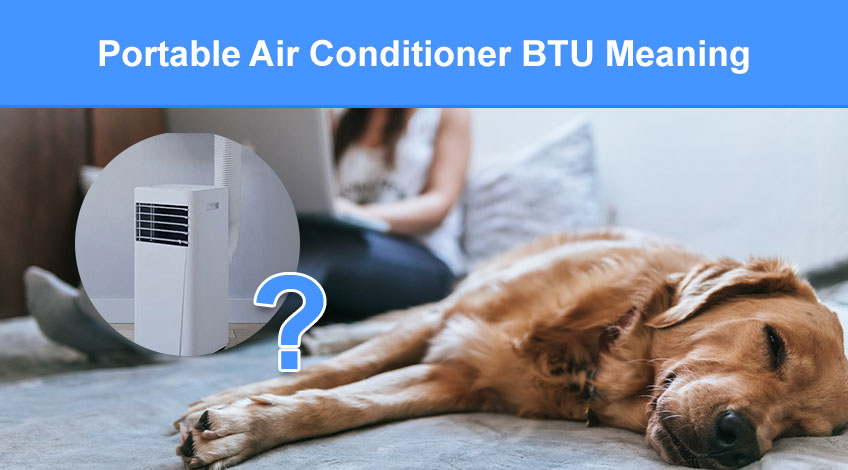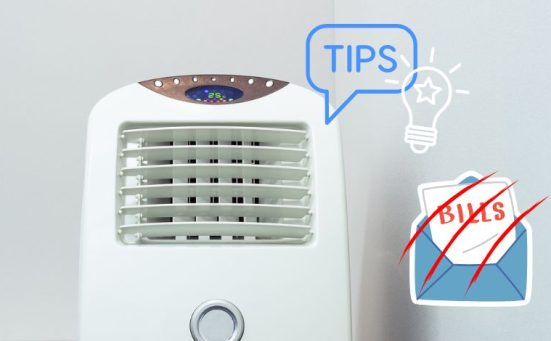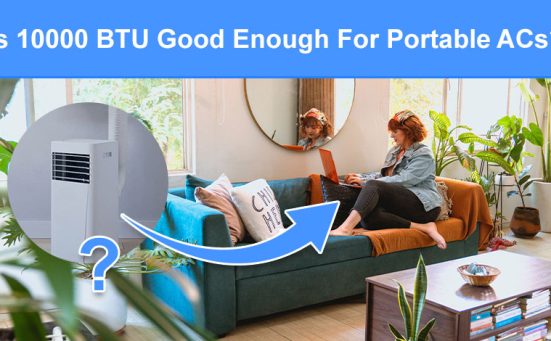
Portable Air Conditioner BTU (what it means & how to choose)
When looking at portable air conditioners you’ll notice somewhere in the specs it will mention BTU. If you want to know what BTU stands for and how it affects your portable air conditioner, keep reading.
What Does BTU Mean?
BTU stands for British Thermal Units which is the way the cooling capacity of portable air conditioners are rated. BTUs are the standard measure of heat exchange and in air conditioners BTUs represent the cooling power.
1 BTU is equal to 1055 joules and 1 watt is equal to 3.413 BTU or 1000 BTU/Hour = 293 watts.
The BTU actually measures the amount of energy needed to raise the temperature of one pound of water by one degree Fahrenheit. So in portable air conditioners the BTU is used to measure how much heat is removed from the room.
This all means that the more BTUs the portable air conditioner has, the bigger the area it can cool and the faster it can cool.
How Many BTUs Do You Need?
Most portable air conditioners will include a recommended maximum room size for the product in the specs. There can be some variations in how different manufacturers rate room capacities.
But as a rough guide;
| Room Size | Recommended BTUs Required |
|---|---|
| 100 to 150 square feet (small/medium rooms with average ceilings) | 5000 to 6000 BTUs |
| 150 to 400 square feet (medium/large rooms with average ceilings) | 6500 to 8000 BTUs |
| 400 to 800 square feet (medium/large rooms with average ceilings) | 8000 to 12000 BTUs |
To calculate the square footage of your room, all you need to do is multiply the length by the width.
Which in our example room means multiplying 15 x 14 which gives us a square footage of 210 because
15ft x 14ft = 210
Exact BTU Calculation
To calculate exactly how many BTUs are required to cool a room of a particular size you can use this simple calculation;
Simply measure the room and then multiply the length by the width and then by the height and finally multiply by five.
L x W x H x 5 = BTUs
If we measure our room we find that it is 15 feet long, 14 feet wide and has a height of 8 feet. Which means we would need a portable air conditioner of at least 8400 BTU.
This is because 15ft x 14ft x 8ft x 5 = 8400 BTU.
Additional Factors You Need To Take Into Account
Once you know exactly how many BTUs you need to cool your room there is another number you need to factor in. Which is how many people are likely to be in that room.
For every person in the room, you should add 1000 BTUs. Which means in our room where there are two of us, we now need to buy a portable air conditioner with a cooling capacity of at least 10,400 BTU (8400 + 2000).
And it’s not only people that add to the heat of a room, anything electrical will add to the heat.
For example; TVs, computers, even light bulbs all add to the heat in a room and if there are a number of computers like in an office, you will need to factor that into your BTU requirements as well.
Be Careful With Excessive BTUs
We’ve just told you that sometimes you need to add extra BTUs because you need to factor people into the equation. This can sometimes lead to thinking that more BTUs is better.
Well, it is but only up to a point. For instance if you were to install a portable air conditioner with a 12000 BTU rating in a room measuring 150 square feet it will cool that room very quickly.
However, there is the possibility that it will cool the room too fast. Which could mean that there’s still excess humidity left in the room. This will eventually lead to you sitting in a damp room.
There’s also the aspect of wasting electricity with a bigger unit than is absolutely necessary. A portable air conditioner with a 1000 BTU rating will use an average of 100 watts (0.10 kilowatts) per hour.
How Much Will It Cost To Run A Portable A/C ?
Using a 9000 BTU portable air conditioner as an example, with 990 watts. We first need to convert the wattage to kW/h to do this we need to divide the watts by 1000 which equals 0.99 kW/h.
We then have to multiply this figure by the current charge per unit of electricity which is 34p per unit. Which means it will cost 0.34p to run that particular unit for one hour.
We arrived at this figure because;
990 ÷ 1000 = 0.99 x 34 = 34p
As long as you know the wattage of the portable air conditioner and the price per unit you are charged for your electricity, you can use the above formula to work out how much it will cost you to run any unit.
For more information on how much it costs to run a portable air conditioner follow this link.
Added Costs To Consider
Many portable air conditioners run inefficiently because the exhaust hose has splits or tears. These splits allow heat back into the room which means the unit is working against itself as well as the room’s heat.
You will need to pay attention to the exhaust hose and the window kit. The window kit needs to create a solid seal so as to not allow any warm air back into the room.
This can often be achieved using duct tape or similar.
SEE ALSO: The Best Portable Air Conditioners (top UK aircon units reviewed)
Frequently Asked Questions
How many BTUs you need for your room depends on the overall size of the room. For instance, a portable air conditioner with 8000 BTUs will cool a room up to around 400 square feet. A unit with 6000 BTUs will cool a room up to around 150 square feet.
If you get a portable air conditioner with a BTU rating that is too high it could leave the room damp and be detrimental to the A/C unit too.
It depends on the size of your bedroom, a 8000 BTU portable air conditioner will cool a room of around 400 square feet.
Yes, a higher BTU usually means that the portable air conditioner will use more electricity.
The ideal situation is to buy a portable air conditioner of just a little more BTUs than you have calculated that you will need. However if the BTU rate is too low, the unit will have to run for far longer which will increase your power usage and your subsequent electricity charge. Too high and the room will cool too fast and become damp.
Also, follow us on Pinterest ...



